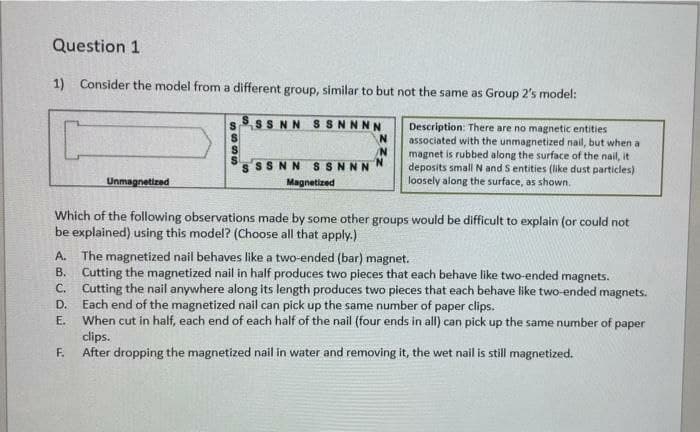1) Consider the model from a different group, similar to but not the same as Group 2's model: SSNN SSNNNN Description: There are no magnetic entities associated with the unmagnetized nail, but when a magnet is rubbed along the surface of the nail, it deposits small N and S entities (like dust particles) loosely along the surface, as shown. SSNN SSNNN Unmagnetized Magnetized Which of the following observations made by some other groups would be difficult to explain (or could not be explained) using this model? (Choose all that apply.) A. The magnetized nail behaves like a two-ended (bar) magnet. B. Cutting the magnetized nail in half produces two pieces that each behave like two-ended magnets. C. Cutting the nail anywhere along its length produces two pieces that each behave like two-ended magnets. Each end of the magnetized nail can pick up the same number of paper clips. When cut in half, each end of each half of the nail (four ends in all) can pick up the same number of paper clips. After dropping the magnetized nail in water and removing it, the wet nail is still magnetized. D. E. F.
1) Consider the model from a different group, similar to but not the same as Group 2's model: SSNN SSNNNN Description: There are no magnetic entities associated with the unmagnetized nail, but when a magnet is rubbed along the surface of the nail, it deposits small N and S entities (like dust particles) loosely along the surface, as shown. SSNN SSNNN Unmagnetized Magnetized Which of the following observations made by some other groups would be difficult to explain (or could not be explained) using this model? (Choose all that apply.) A. The magnetized nail behaves like a two-ended (bar) magnet. B. Cutting the magnetized nail in half produces two pieces that each behave like two-ended magnets. C. Cutting the nail anywhere along its length produces two pieces that each behave like two-ended magnets. Each end of the magnetized nail can pick up the same number of paper clips. When cut in half, each end of each half of the nail (four ends in all) can pick up the same number of paper clips. After dropping the magnetized nail in water and removing it, the wet nail is still magnetized. D. E. F.
Related questions
Question
I need detailed ans of this objective question

Transcribed Image Text:Question 1
1) Consider the model from a different group, similar to but not the same as Group 2's model:
SSSNN SSNNNN
Description: There are no magnetic entities
associated with the unmagnetized nail, but when a
magnet is rubbed along the surface of the nail, it
deposits small N and S entities (like dust particles)
loosely along the surface, as shown.
/N
SSNN SSNNN
Unmagnetized
Magnetized
Which of the following observations made by some other groups would be difficult to explain (or could not
be explained) using this model? (Choose all that apply.)
The magnetized nail behaves like a two-ended (bar) magnet.
B. Cutting the magnetized nail in half produces two pieces that each behave like two-ended magnets.
C. Cutting the nail anywhere along its length produces two pieces that each behave like two-ended magnets.
Each end of the magnetized nail can pick up the same number of paper clips.
When cut in half, each end of each half of the nail (four ends in all) can pick up the same number of paper
clips.
After dropping the magnetized nail in water and removing it, the wet nail is still magnetized.
A.
D.
E.
F.
Expert Solution
This question has been solved!
Explore an expertly crafted, step-by-step solution for a thorough understanding of key concepts.
This is a popular solution!
Trending now
This is a popular solution!
Step by step
Solved in 2 steps
